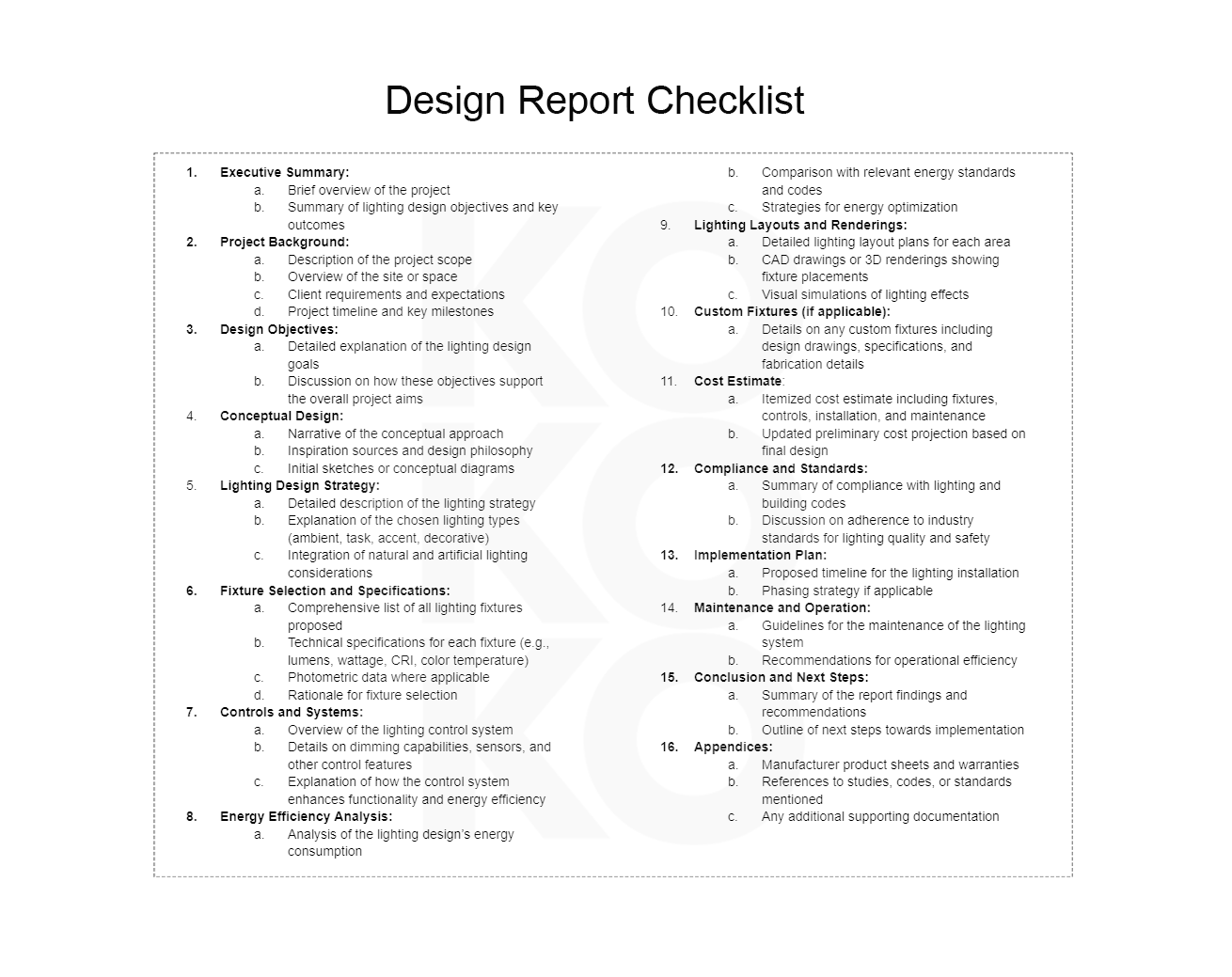PICK A LIGHT
Chapter Seven:
Refine and Define
- Owner of Knockout Lighting Design Inc.
Prepare Design Report and Presentation...
As the lighting design process transitions from detailed design development to stakeholder engagement and project approval, the preparation of a design report and presentation is an important step. This documentation serves as a comprehensive record of the design intent, technical specifications, and the aesthetic and functional benefits of the proposed lighting system. To clients, stakeholders, and project teams, it is a crucial tool for communicating complex ideas.
Design Report Documentation
A thorough design report is essential for documenting the intricate details of the lighting design. It should encompass an introduction to the design objectives, a detailed narrative of the conceptual approach, and a comprehensive breakdown of the lighting fixtures and systems proposed, including technical specifications, energy considerations, and cost analyses. This document acts as a reference point throughout the project lifecycle, ensuring that all project participants have a clear understanding of the design intentions and parameters.
When compiling the design report, prioritize clarity. Use concise language to describe design concepts and decisions, and support these descriptions with technical data, diagrams, and photometric studies where appropriate. Visual aids such as CAD drawings, renderings, and sample boards can greatly enhance the report’s readability and effectiveness, making complex technical information more accessible to non-specialist audiences.
Visual and Technical Presentation
The presentation is an opportunity to bring the design report to life, showcasing the proposed lighting design in a dynamic and engaging format. This should not only highlight the aesthetic appeal of the design but also articulate its functional benefits, such as improved occupant comfort, energy efficiency, and adaptability to different uses of the space. Effective presentations leverage visual storytelling, using before-and-after scenarios, 3D renderings, and simulations to illustrate the lighting design.
Visualize the lighting design concept in a variety of ways. The inclusion of interactive elements, such as virtual or augmented reality experiences, can provide stakeholders with an immersive view of the proposed design, which facilitates a deeper understanding. Engaging and supporting stakeholders can also be enhanced by tailoring the presentation content to their specific interests and concerns.
Active and ongoing engagement with stakeholders throughout the development of the design report and presentation ensures that the project remains aligned with client expectations and project goals. The dialogue is crucial for refining the design based on stakeholder feedback, addressing concerns, and building consensus.
Incorporate structured feedback mechanisms, such as surveys or focused discussion groups, to gather insights from stakeholders at various stages of the report and presentation development. This feedback can provide valuable perspectives that refine and improve the design, increasing the likelihood of project approval and successful implementation.
Final Review and Concept Approval
The final review and approval process is a critical milestone, where the design report and presentation are formally submitted to decision-makers. Success at this stage hinges on the clarity, coherence, and persuasiveness of the documentation, as well as the designer’s ability to articulate and defend the design choices made.
Anticipate and prepare for potential questions or objections that may arise during the review process. Providing clear, reasoned responses and demonstrating a willingness to adapt the design as needed can facilitate a productive dialogue and lead to positive outcomes.
Preparing the design report and presenting it goes well beyond a procedural step; it is an opportunity to express a vision and demonstrate the value and feasibility of the proposed lighting design. A lighting professional can ensure the success of their project through careful planning, creative presentation, and strategic engagement with stakeholders.
Feedback Incorporation
For the design to be refined, it is essential to gather and incorporate feedback. This includes input from clients, architects, interior designers, and potentially the end-users of the space. Feedback can provide valuable perspectives that may highlight areas for improvement or suggest alterations that could enhance the design’s effectiveness and appeal.
Keep an open line of communication with all stakeholders and encourage honest feedback. Use this input as a constructive tool to guide your revisions, ensuring the final design not only looks good but also works well for everyone involved.

Technical Adjustments
Based on the preliminary calculations, you may need to make technical adjustments to the lighting plan. This could involve changing the type or placement of fixtures to improve illumination, adjusting the lighting controls for better functionality, or finding more energy-efficient solutions to stay within budget.
Stay flexible and be willing to explore alternative solutions that may offer better outcomes. Sometimes, a small technical modification can significantly enhance the lighting experience or reduce costs.
Budget Reevaluation
The project budget should be revisited after the design has been refined based on feedback and technical adjustments. This reevaluation ensures that the refined design remains within financial constraints while achieving the desired lighting effects. It’s an opportunity to identify cost-saving measures or areas where reallocating funds could improve the overall design.
Look for creative ways to achieve your design goals in a quality-conscious manner. This might include opting for multi-functional fixtures or leveraging natural light to reduce the reliance on artificial lighting.
Finalizing the Design
With feedback incorporated, technical adjustments made, and the budget updated, the final step in refining the design concept is to finalize the details. This includes confirming the fixture selections, lighting layouts, control schemes, and any custom elements that will be part of the project. Before finalizing, take a big step back and review the entire design from both a technical and aesthetic perspective. Make sure the lighting plan still aligns with the project’s goals and creates the intended atmosphere.
Finalize Product Specifications
The first step involves finalizing the specifications for lighting fixtures, controls, and custom elements. In order to achieve this, each product’s technical attributes must be thoroughly examined, such as its lighting output, energy efficiency, CRI, and physical dimensions, to ensure they align with the space’s functional needs and design intentions.
Engage with manufacturers to confirm the specifications and availability of chosen products. It’s wise to have alternatives in case of unforeseen discontinuations or supply issues, ensuring the project stays on track without compromising design integrity.
Detailed Design Documentation
Creating detailed design documentation is essential. This comprehensive set of documents includes lighting plans, installation details, wiring diagrams, and control system schematics. These documents serve as the definitive guide for the installation team, guiding the execution of the lighting design.
Be sure the documentation is clear and detailed, with annotations for installation nuances that might not be immediately obvious. In order to prevent misinterpretations and errors during installation, a detailed legend and explanation should be provided for each symbol.
Energy Compliance and Sustainability Reporting
This report demonstrates how the lighting design adheres to local energy codes and contributes to sustainability objectives, detailing measures taken to minimize energy consumption and the environmental impact of the lighting system.
Clearly document the benefits of energy-saving features and sustainable design practices. This not only aids in approvals but can also be a compelling part of the project’s narrative, especially for projects seeking green certifications.
Implementation Planning
Effective implementation planning is crucial for lighting designers to bring their concepts to life. This requires careful scheduling, close coordination with other construction disciplines, and setting clear milestones. A well-structured plan ensures smooth execution and integration of the lighting design within the overall project framework. Maintaining open communication with all project team members is essential. Regular check-ins help address any issues promptly, and having contingency plans in place prepares for unexpected challenges.
As the project moves into the implementation phase, attention to detail becomes increasingly important. Collaborating closely with contractors, enforcing strict quality standards, and facilitating a thorough handover process are essential steps in implementing designs. Post-occupancy evaluations provide valuable feedback from end-users, guiding future lighting projects.
Light design success lies in balancing aesthetics, functionality, and energy efficiency. Embracing transparent communication, adaptability, and a commitment to excellence allows lighting designers to create spaces that meet clients’ expectations. As a result of this comprehensive approach, it is evident that thoughtful lighting design can have a profound impact on transforming spaces and enriching lives.
Lighting Analysis Calculator
Select a Calculation:
Total Energy Cost
Calculate the total energy costs including usage and demand charges.
Total Energy Cost:
Operational Hours Impact
Calculate annual energy usage based on operational hours and power rating.
Annual Energy Usage:
Lighting Efficiency Ratio (LER)
Calculate the efficiency of lighting by lumens per watt.
Efficiency Ratio:
Lifetime Cost of Lighting
Estimate the total cost of ownership for lighting, including energy, replacement, and maintenance costs over its lifetime.
Total Lifetime Cost:
Disclaimer: This tool provides estimates only and is not a substitute for professional advice. Consult a qualified professional for detailed lighting planning and compliance with standards.

